“Just Home”—a NYC Health + Hospitals (HHC) plan to convert an empty staff residence on the Jacobi Hospital campus into supportive housing for a few dozen people with serious medical problems discharged from Rikers Island—is a pressure cooker for many of the most fraught issues in the city: homelessness, mental health, development, and the risk of crime, whether real or perceived.

Adi Talwar
Multiple houses near Seminole Avenue had signs opposing the Just Home project.This story has been updated with a response from Councilmember Marjorie Velázquez.
Each year, thousands of New York City residents cycle from the streets and shelters to Rikers Island jails, with scant housing options to provide stability after their release.
A report issued earlier this year by the Corporation for Supportive Housing (CSH) found that about one in five people arrested and sent to Rikers in 2020 were homeless and experiencing mental illness, meaning they could qualify for supportive housing—permanent apartments with on-site services. All told, that’s 2,589 people—almost certainly an undercount, according to the report’s authors. Their confinement costs the city more than $1.4 billion per year, with little by way of support or permanent housing to show for it.
Housing, on the other hand, provides a level of stability and offers care, which advocates say helps increase the likelihood that homeless New Yorkers released from jail do not return. CSH’s New York City Director Patricia Hernandez said the city needs to open and fill hundreds of supportive apartments to meet the need—two of the policy proposals in the report. “A model that just takes in clients with a kind of Housing First approach and removing all the barriers would be really helpful,” she said.
But building just 50 of those apartments is proving to be a problem.
The streets of the Indian Village section of Morris Park are lined with signs denouncing a NYC Health + Hospitals (HHC) plan to convert an empty staff residence on the adjacent campus of Jacobi Hospital into a supportive housing site known as “Just Home” for a few dozen people with serious medical problems discharged from Rikers Island jails.
“Not Here, Not Now, Not Ever,” read the signs, posted next to Christmas decorations in the front yards of the neighborhood’s neat single-family, Tudor-style homes.
“This is a quiet neighborhood,” said Frank Muscara, a retired bank technology risk officer, as he stood in his doorway Thursday. “I don’t think that kind of facility has any place here.”
Muscara, 68, said he thinks Just Home will house people who are arrested and immediately released because of “bail reform,” or as part of an ongoing plan to close Rikers Island’s isolated jails and open smaller detention centers in four of the five boroughs.
The plan faces the kind of backlash typical of projects that would bring low-income housing or services for the formerly homeless to New York City’s middle- and upper-middle class neighborhoods, with the debate informed by realities of race—most people detained on Rikers are Black or Latino, most Indian Village residents are white home-owners—and resentment toward neighborhood change and accusations of discrimination. The Just Home project is also a pressure cooker for many of the most fraught issues in the city: homelessness, mental health, development, and the risk of crime, whether real or perceived. Misinformation and assumptions have informed some of the opposition.
The building, which is physically separated from the suburban Indian Village by a brick wall and fence, would specifically house people with “complex medical needs that cannot be well managed in shelter or on the street,” like active cancer and kidney failure, according to the Fortune Society, the reentry service provider that would run the building. Fortune Society operates a similar supportive housing site in Hamilton Heights called Castle Gardens, with another in East Harlem set to open.
The site is one of a handful of proposed residences for people with serious medical needs planned near city-owned hospitals. Last month, Mayor Eric Adams announced an effort to develop 650 units of affordable and supportive housing on municipal hospital campuses, including recently opened apartments at Queens Hospital Center in Jamaica. That same Queens plan also faced opposition when it was first introduced nine years ago.
Roxanne Delgado, who lives a few blocks from Jacobi and leads the civic organization Friends of Pelham Parkway, said opposing the Just Home plan is hypocritical, pointing to similar public backlash against homeless shelters and homeless encampments from the same critics who oppose new affordable housing development. “We can’t complain about problems and then, when there is a viable solution say, ‘Well, no, I don’t want that either,’” she said.
Plenty of people are making that case, however. And so far, they seem to have the ear of local Councilmember Marjorie Velázquez.
Just Home requires City Council approval, and the full Council traditionally defers to the local member on land use issues. So far, Velázquez has opposed the plan, citing a lack of community consultation, despite a series of public hearings, and appearing at a protest near the wall that separates the Jacobi campus and the vacant building from Indian Village.
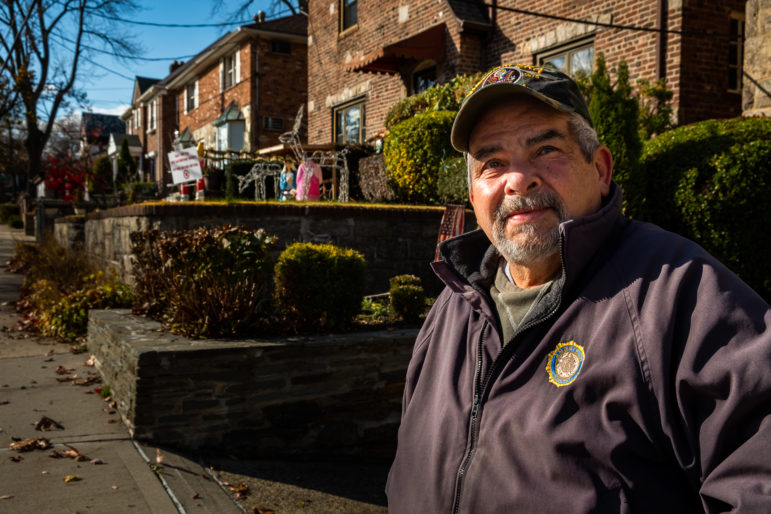
Adi Talwar
Mike Salveggi, 79, a former facility’s engineer at the Jacobi Campus who bought a home on Pawnee Place four years ago, is opposed to the proposed Just Home project. “Jacobi could have done something better with that building,” he said.
Velázquez’s spokesperson said the councilmember was traveling and did not have time to discuss the plan. Following publication of this story Monday, Velázquez sent City Limits a statement saying that she has had many conversations about the project with city agencies, Jacobi Hospital, the Fortune Society and local community groups.
“These discussions have served as a platform to identify what the community would like to see in this space,” she said. “I hope we can find a use for the building that works for the community, patients and the hospital.”
Delgado accused Velázquez of “pandering to political pressure from the loudest voices”—the opponents screaming about the plan to house a handful of people who have served their time in jail or who are awaiting trial.
She said people who worry the new neighbors would commit crimes should consider the layers of security and stability baked into the proposal. The NYPD’s 49th Precinct is located next to the Jacobi campus, the hospital has its own security and Fortune Society will provide their own oversight.
Some neighbors, she said, have taken a somewhat softer view of the plan once they learn some of the specifics.
“They tell me, ’Have you heard they’re going to put Rikers there?’” she said. “I tell them ‘It’s not a jail. They have medical issues’ and then they’re more sympathetic.”
“You won’t find people jumping for joy saying we want this,” she continued. “But they say, ‘Well it makes sense that it’s in the hospital because the 49th Precinct is right next door,’”
Two IT workers who parked in Indian Village before walking to their job at nearby Montefiore Hospital demonstrated that change in perception when discussing the plan Thursday. Both declined to give their names but immediately rejected the project when they thought the proposal was a “halfway house” for people discharged from Rikers while awaiting trial.
Informed that the building would instead provide permanent housing for people with serious medical needs, the pair changed their attitude.
“That’s something I could see,” said one of the two men. “Something holistic like that.”
Yet all of the residents who talked with City Limits Wednesday and Thursday morning were steadfast in their opposition. The yard signs were ubiquitous.
“It’s people coming out of jail who have nowhere else to go,” said Phyllis Sacco, who has lived a few blocks from the wall separating the hospital campus for 28 years. “Maybe it’s only for people who were sick and disabled and couldn’t leave the premises, I’d support it.”
“I’m afraid for the kids, for myself,” added her neighbor, Dolores Dunne. “I’m thinking of selling.”
Other residents blowing leaves from their driveways or standing outside their homes warned that neighbors would begin moving out if the Just Home plan goes through. They said several have already put their homes on the market, though City Limits only saw one for sale sign outside a stately home on Pawnee Place, across from the proposed site, Thursday.
A 2008 study by the Furman Center found that property values actually increase following introduction of a supportive housing site. The Pawnee Place home is listed for sale at $899,000.
Fear and perceptions of crime drive the opposition, even as Fortune Society and HHC have attempted to diffuse those concerns through detailed information sheets.
“The plan is to bring released inmates to the community,” said Irene Estrada, a former Democratic district leader who organized the group Mothers Against 1900 Seminole, the address where the project would be housed. “Crime is out of control in the five boroughs as it is.”
“Jacobi could have done something better with that building,” added Mike Salveggi, 79, a retired facility engineer for the hospital who lives down the street from the home for sale. He gestured to homes on the blocks. “There are kids around.”
Salveggi suggested the city put the people discharged from jail while they await trial or after they serve their sentences into hotels instead.
“They need to be someplace else where they can take care of that,” he said. “I’m not for it.”
The most vocal opponents have merged misinformation with the familiar apprehension. The Bronx Republican Party has dubbed the plan the “Jacobi Hospital Rikers Release project” in fliers issued ahead of an upcoming toy drive for an organization serving survivors of domestic violence. Community Board 11 hearings on the proposal have devolved into frenzied chaos, as the Bronx Times has reported, as members and attendees shouted discriminatory slogans about the formerly incarcerated while drowning out and even threatening supporters.
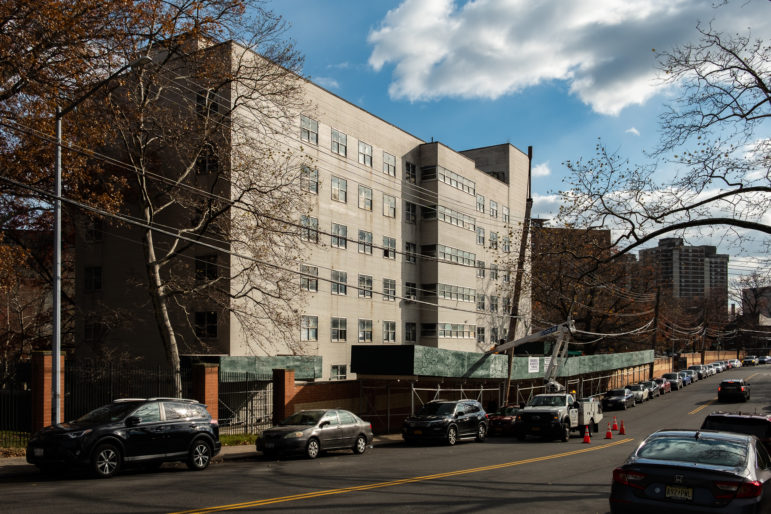
Adi Talwar
View from Seminole Avenue of the proposed Just Home project building on Jacobi Medical Center’s campus.
At an October community board leadership meeting, former Assembly candidate Gene DeFrancis, who is not a member of the community board, criticized a plan to consolidate the residents in “a ghetto-style building.” He was previously filmed discussing how opponents should punch a project proponent who has frequently documented protests and community board hearings.
Community Board 11 Vice Chair Al D’Angelo started an online fundraiser to fight the proposal and has repeatedly spoken out against it. “What you are building is low-cost housing for ex-convicts,” D’Angelo said at a community board hearing in September. He called on elected officials to cut funding to HHC “until they come to their senses and do something that is truly beneficial to our community,” like building senior housing or child services. “The Bronx will never achieve the status of the other boroughs if you keep dumping on The Bronx,” he added.
Neither man responded to emails seeking comment.
A demonstration last month outside the office of local Assemblymember Nathalia Fernandez, who has no say on the project in her state legislative role, doubled as a rally for political candidates aligned with ex-President Donald Trump.
Fortune Society CEO JoAnne Page, no stranger to community protests against her organization’s projects, said the opposition to Just Home has surpassed anything she has seen.
She also questioned district residents who say they are being unduly burdened by low-income housing and services for formerly homeless New Yorkers: Council District 13, where Just Home would be located, produced just 58 units of income-restricted housing over the past decade, though a recently approved upzoning along Bruckner Boulevard will pave the way for another 168. That upzoning, which Velázquez supported after the Council appeared poised to override her opposition, has continued to face intense opposition in the Throggs Neck section of the district.
Community District 11, meanwhile, does not have a single homeless shelter, even though 546 people in the Department of Homeless Services (DHS) shelter system on June 30 listed a last permanent address in the district, according to agency records shared with City Limits.
“Just Home works on ending this vicious cycle where people go between emergency rooms and jails and shelters and detox and prison,” Page said. “What this is is desperately needed and it addresses problems in this community as well as in the city.
The Fortune Society and HHC have already made one concession to residents: The address of the building will change from 1900 Seminole Ave.—the road that forms the perimeter of Indian Village—to a number on Pelham Parkway, matching the rest of the Jacobi Campus.
The bottom line, say supporters of the plan, is that all New Yorkers, including people with criminal justice histories, deserve a stable place to live.
“New York City has a dire need for supportive housing for our most vulnerable citizens, and few are more vulnerable than those exiting the justice system with serious health conditions,” said Department of Housing Preservation and Development Commissioner Adolfo Carrión Jr, the former Bronx Borough President.
As the plan heads for an eventual Council hearing before a binding vote, a diverse coalition of justice reform organizations and pro-development groups have stood up in favor.
The district manager of Manhattan’s Community Board 9, which meets inside Fortune Society’s Castle Gardens supportive housing site, also submitted a letter of support for the organization.
“The residents, and Fortune Society, have proven to be assets in the neighborhood,” wrote District Manager Eutha Prince. Residents would not move into Just Home until 2025, the organization and HHC estimate.
Nearly every single person on Rikers Island will be released at some point. And when they get out, they will need a place to live, said Darren Mack, a formerly incarcerated organizer with the Freedom Agenda project of the Urban Justice Center.
Restricting their housing options serves no one, especially if they have special needs, Mack said during an interview on WBAI’s City Watch last month.
“Some people need housing, some people need wraparound supportive services,” he said. “We need to expand them. We need to invest in them.”
He urged New Yorkers to see beyond their fears when it comes to projects like Just Home.
“Many people who are formerly incarcerated, we are great neighbors,” he said.


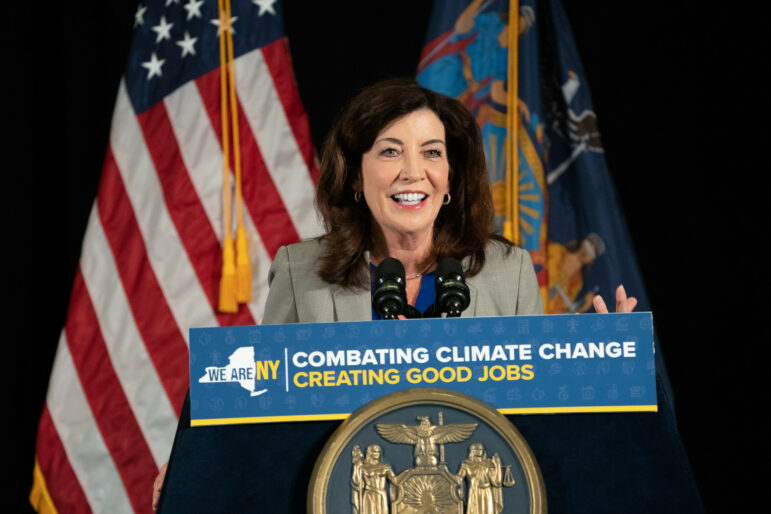

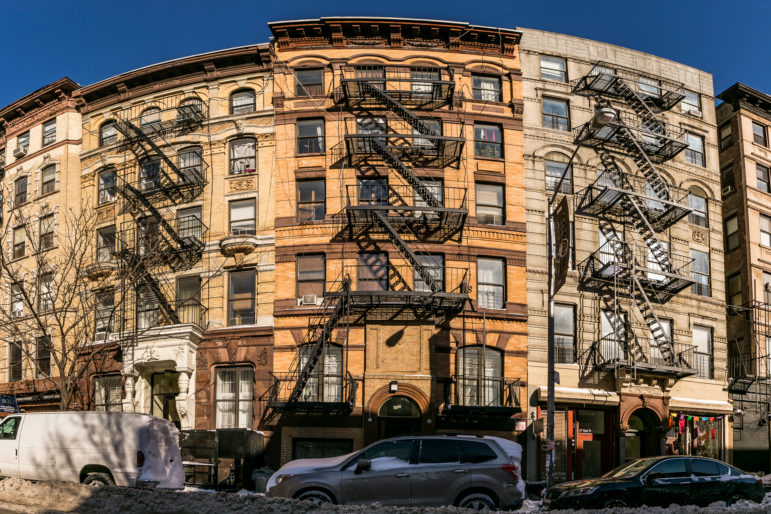
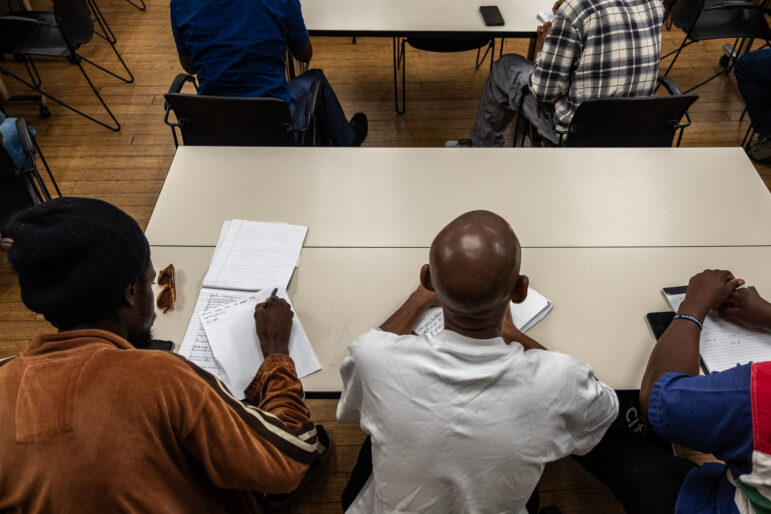
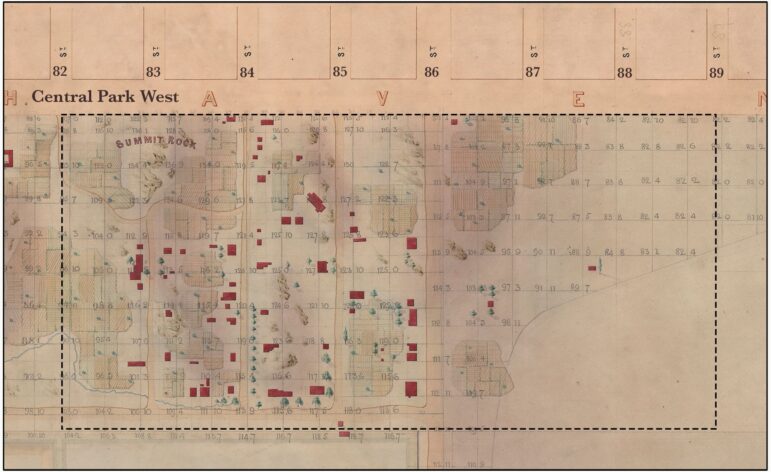


3 thoughts on “NYC Needs Thousands of Apartments for the Formerly Incarcerated. 50 Face Furious Opposition”
The article captures the neighborhood reactions in a balanced way. It is very interesting how some individuals are open to permanent supportive housing once the concept is fully explained. here’s a quieter chapter from the neighborhood’s past . https://www.bxtimes.com/once-troubled-brooklyn-residents-briefly-find-home-in-pelham-bay-apartment-2/
This is an obviously biased piece that does not highlight any of the real reason why the overwhelming majority of Morris Park is against the proposal. In fact the community board passed a sweeping advisory vote to stop the proposal. Here are just some of the reasons why the idea should be tossed:
Current arguments:
1. The location has no convenient access to groceries, parking, recreation or suitable jobs.
2. Nearby bus routes are severely over-crowded.
3. Jacobi security is currently overwhelmed and cannot sustain the additional responsibilities of this project.
4. Jacobi health employees are under-staffed and in some cases it takes a year plus to schedule an appointment. How would the tenants get the care they need? How would the community be able to attain the healthcare it needs within a reasonable timeframe?
5. The 49th precinct currently has difficulty doing police work with stretched resources as is. This project would place additional unsustainable burdens on the precinct.
6. Providing lighting and security cameras is a pathetic remedy to ensuring safety of tenants, staff and neighbors.
7. Fortune Society has not been forthcoming on the types of criminal histories of tenants that would be allowed into the building.
8. The project is directly adjacent to several schools. It is unreasonable to house pedophiles, rapists, murderers etc next to children, other patients and seniors.
9. There is reasonable likelihood that tenants would have substance abuse issues, which further increases the risk of dangerous occurrences.
10. Fortune Society has not provided any empirical evidence showing a positive impact on recidivism or other important measures.
11. Old data suggests that Fortune Society may in fact have a negative impact on recidivism rates.
12. Fortune Society claims that they do not have the funding to perform an empirical study yet they are able to pay their CEO, Joanne Page, 250k+ per year and they are able to pay for expensive litigation against large companies like Macy’s and Target.
13. Fortune Society’s chairman, Dennis Kozlowski, was convicted of stealing millions from Tyco International while CEO.
14. Fortune Society currently operates a similar program in Harlem at a building named Castle Garden and the local community is still expressing opposition and requesting removal.
15. Fortune Society has demonstrated a poor track record with their ability to handle unruly tenants as illustrated by the case of Roderick Compass.
16. Fortune Society has provided no data on how they will continue to financially operate the building. We do not know the sources and numbers behind revenues and expenses.
17. Fortune Society has not provided a lease template of what would be given to tenants.
18. Morris Park already does its fair share because it is home to the Bronx Psychiatric Center, which houses individuals with serious mental illness. Since this is a state-run facility it is not counted in the fair share methodology.
19. More than 40% of Rikers inmates have been treated for mental illness. There is a high likelihood that tenants would have mental illness which means that Morris Park would be taking on even more mentally ill individuals.
20. Rikers island was built on a former landfill and as a result many prisoners and prison staffers have developed diseases from the toxic fumes that spew from the land. Morris Park is now being asked to bear the burden of poor city planning and inhumane treatment of prisoners.
21. The Bronx has the most shelters and group homes per capita than any other borough. This number does not even consider all of the homeless housed in Bronx hotels.
22. Bronx shelters also have the highest rate of homeless individuals that are not originally from the Bronx.
23. There is an attempt to consider Just Home as affordable housing but there is no other affordable housing proposal like this that currently exists in the city. Is is unlike any other proposal because it is not simply affordable housing.
24. Just Home is not considered a shelter but it would be housing pre-trial detainees and former convicts that would otherwise be homeless. If it is housing people that would otherwise be homeless then it is in fact at least partially a shelter.
25. The Bronx has become a target for shelters partly because the land is cheaper but it is only cheaper because the city does not allow our communities to flourish and instead exports problems from other boroughs to the Bronx only to the benefit of the other boroughs.
26. Seniors in retirement that are surviving solely on social security currently have the equity in their home to provide a lifeline in case of an emergency. This project would have a significant impact on reducing that equity by destroying property values.
You are absolutely correct that the city (and state) dump on The Bronx. Sadly it has been that way since the 1970’s. Hopefully more like you will take a stand.